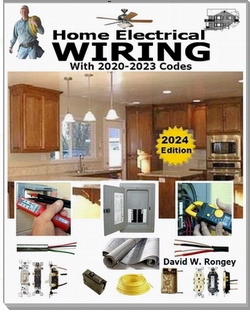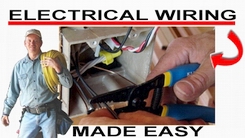» Surge Power Conditioning
» Need Electrical Help? Ask the Electrician
Home Surge Protection

|
By Dave Rongey
Summary: This article explains what surge devices are available and how they can help protect your home with Home Surge Protection Methods. © By: Dave Rongey |
Circuit Breaker and Secondary Surge Arrester
Secondary Surge Arrester
This device meets the growing need for surge protection as households have added increasing amounts of transient-sensitive, semiconductor-based electrical and electronic equipment.
By installing this new Siemens device in the load center of the residence, surge protection is provided for all branch circuits, fixtures, appliances, motors, and other electronic and electrical equipment in the house served by that load center.
 |
The Siemens Company has announced the availability of its latest innovation - a circuit breaker / surge arrester that protects the electrical system against lightning strikes, utility switching surges, and in-home-generated transients. |
Two red LED lights indicate that surge protection is provided for all circuits connected to the panel board. As a Siemens exclusive feature, the device notifies the owner of loss of surge protection by tripping one or both of the circuit breakers. These breakers should be used for circuit protection of frequently used household or facility circuits because the lights and devices connected to these circuits provide an effective indication that surge protection is being provided. If one or both of the circuit breakers have tripped, turn both circuit breakers to the "OFF" then "ON" position. If either light is not illuminated, the device may still be used for circuit protection, but surge protection is no longer provided and the device should be replaced by a qualified electrician. All Type QP circuit breakers and secondary surge arresters are plug-on style, with load terminals provided. The devices are rated for 120/240V AC and are calibrated for 40 degrees C maximum ambient applications. |
|
The Safest Way to Test Electrical Devices and Identify Electric Wires!The Non-Contact Electrical TesterThis is a testing tool that I have had in my personal electrical tool pouch for years, and is the first test tool I grab to help identify electrical wiring. It is a Non-contact tester that I use to easily Detect Voltage in Cables, Cords, Circuit Breakers, Lighting Fixtures, Switches, Outlets and Wires. Simply insert the end of the tester into an outlet, lamp socket, or hold the end of the tester against the wire you wish to test. Very handy and easy to use.
The Quickest Way to Check for Faulty Electrical Wiring!The Plug-In Outlet TesterThis is the first tool I grab to troubleshoot a problem with outlet circuit wiring. This popular tester is also used by most inspectors to test for power and check the polarity of circuit wiring. It detects probable improper wiring conditions in standard 110-125 VAC outlets Provides 6 probable wiring conditions that are quick and easy to read for ultimate efficiency Lights indicate if wiring is correct and indicator light chart is included Tests standard 3-wire outlets UL Listed Light indicates if wiring is incorrect Very handy and easy to use.
Strip Off Wire Insulation without Nicking and Damaging the Electric Wire!The Wire Stripper and Wire CutterMy absolute favorite wire stripping tool that I have had in my personal electrical tool pouch for years, and this is the tool I use to safely strip electrical wires. This handy tool has multiple uses: The wire gauges are shown on the side of the tool so you know which slot to use for stripping insulation. The end of the tool can be used to grip and bend wire which is handy for attaching wire onto the screw terminals of switches and outlets.. The wire stripper will work on both solid and stranded wire. This tool is Very Handy and Easy to Use. |
||
Residential Electrical Parts and AccessoriesLight Switches 120volt Outlets Circuit Breakers Electrician Tools Voltage Testers |















